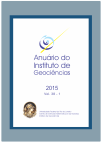Assessment of the Particulate Matter Behavior According to Synoptic Situations and Source Regions. Case of Study, Rainless Season in InSTEC
DOI:
https://doi.org/10.11137/2015_2_104_114Keywords:
Particulate matter, Synoptic situations, Source regionsAbstract
The influence of synoptic situations and source regions on heavy metals and radioisotopes are evaluated. The studied area consists of a 5 km radius around the Higher Institute of Technologies and Applied Sciences (InSTEC), where concentrations of PM10 were measured with a high-flow sensor using quartz filters Staplex 20x25 cm Staplex® Type TFAQ810. Levels of heavy metals (Cu, Ni, Cd, Co, Zn, Hg and Pb) were evaluated using the Emission Spectrometry with Inductively Coupled Plasma (ICP-AES) on a VHR JY38 technique, while radioisotopes (7Be, 40K, 212Pb, 214Pb and 208Ti) were measured in a low background gamma camera. Furthermore, analysis of meteorological factors was performed using the Lapinel classification of the Synoptic Situations Types more frequent in Cuba. Subsequently, a statistical analysis was performed. Concentrations of heavy metals and radioisotopes showed differences in the presence of synoptic situations, however, only the 7Be showed statistically significant differences in the presence of low situations and extratropical cyclones. Sources Regions of air masses were determined according to Gomez (2011) and was obtained that the PM10 presents statistically significant differences in concentrations when Zone III, located in the center of the North American continent, provides the air masses. Regarding the weekly differences only the 214Pb showed variation with statistically significant, showing that the contributions are different in magnitude between weekdays and weekends.Downloads
Download data is not yet available.
Downloads
Published
2016-05-10
How to Cite
Zaldivar, L. C., Artiles, M. M. and Ordaz, L. R. (2016) “Assessment of the Particulate Matter Behavior According to Synoptic Situations and Source Regions. Case of Study, Rainless Season in InSTEC”, Anuário do Instituto de Geociências. Rio de Janeiro, BR, 38(2), pp. 104–114. doi: 10.11137/2015_2_104_114.
Issue
Section
não definida
License
This journal is licensed under a Creative Commons — Attribution 4.0 International — CC BY 4.0, which permits use, distribution and reproduction in any medium, provided the original work is properly cited.















